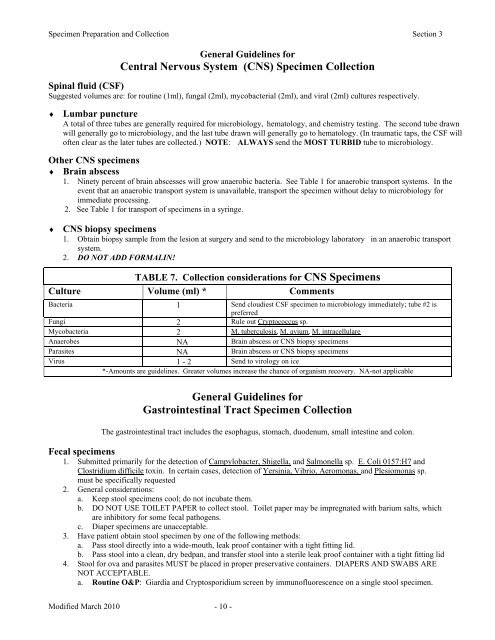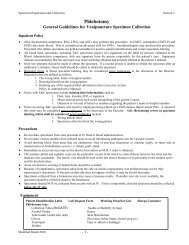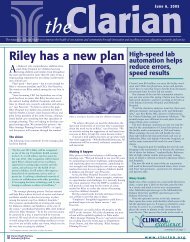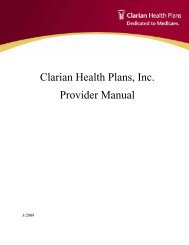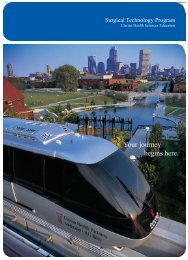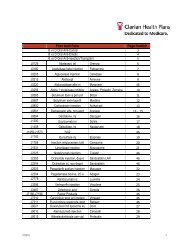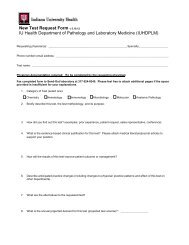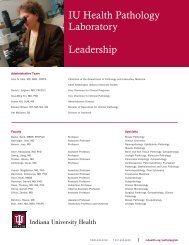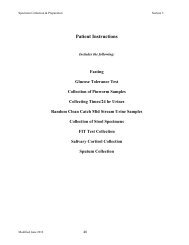Guidelines for Microbiology & Virology - IU Health
Guidelines for Microbiology & Virology - IU Health
Guidelines for Microbiology & Virology - IU Health
Create successful ePaper yourself
Turn your PDF publications into a flip-book with our unique Google optimized e-Paper software.
Specimen Preparation and Collection Section 3<br />
General <strong>Guidelines</strong> <strong>for</strong><br />
Central Nervous System (CNS) Specimen Collection<br />
Spinal fluid (CSF)<br />
Suggested volumes are: <strong>for</strong> routine (1ml), fungal (2ml), mycobacterial (2ml), and viral (2ml) cultures respectively.<br />
♦<br />
Lumbar puncture<br />
A total of three tubes are generally required <strong>for</strong> microbiology, hematology, and chemistry testing. The second tube drawn<br />
will generally go to microbiology, and the last tube drawn will generally go to hematology. (In traumatic taps, the CSF will<br />
often clear as the later tubes are collected.) NOTE: ALWAYS send the MOST TURBID tube to microbiology.<br />
Other CNS specimens<br />
♦ Brain abscess<br />
1. Ninety percent of brain abscesses will grow anaerobic bacteria. See Table 1 <strong>for</strong> anaerobic transport systems. In the<br />
event that an anaerobic transport system is unavailable, transport the specimen without delay to microbiology <strong>for</strong><br />
immediate processing.<br />
2. See Table 1 <strong>for</strong> transport of specimens in a syringe.<br />
♦<br />
CNS biopsy specimens<br />
1. Obtain biopsy sample from the lesion at surgery and send to the microbiology laboratory in an anaerobic transport<br />
system.<br />
2. DO NOT ADD FORMALIN!<br />
TABLE 7. Collection considerations <strong>for</strong> CNS Specimens<br />
Culture Volume (ml) * Comments<br />
Bacteria 1 Send cloudiest CSF specimen to microbiology immediately; tube #2 is<br />
preferred<br />
Fungi 2 Rule out Cryptococcus sp.<br />
Mycobacteria 2 M. tuberculosis, M. avium, M. intracellulare<br />
Anaerobes NA Brain abscess or CNS biopsy specimens<br />
Parasites NA Brain abscess or CNS biopsy specimens<br />
Virus 1 - 2 Send to virology on ice<br />
*-Amounts are guidelines. Greater volumes increase the chance of organism recovery. NA-not applicable<br />
General <strong>Guidelines</strong> <strong>for</strong><br />
Gastrointestinal Tract Specimen Collection<br />
The gastrointestinal tract includes the esophagus, stomach, duodenum, small intestine and colon.<br />
Fecal specimens<br />
1. Submitted primarily <strong>for</strong> the detection of Campylobacter, Shigella, and Salmonella sp. E. Coli 0157:H7 and<br />
Clostridium difficile toxin. In certain cases, detection of Yersinia, Vibrio, Aeromonas, and Plesiomonas sp.<br />
must be specifically requested<br />
2. General considerations:<br />
a. Keep stool specimens cool; do not incubate them.<br />
b. DO NOT USE TOILET PAPER to collect stool. Toilet paper may be impregnated with barium salts, which<br />
are inhibitory <strong>for</strong> some fecal pathogens.<br />
c. Diaper specimens are unacceptable.<br />
3. Have patient obtain stool specimen by one of the following methods:<br />
a. Pass stool directly into a wide-mouth, leak proof container with a tight fitting lid.<br />
b. Pass stool into a clean, dry bedpan, and transfer stool into a sterile leak proof container with a tight fitting lid<br />
4. Stool <strong>for</strong> ova and parasites MUST be placed in proper preservative containers. DIAPERS AND SWABS ARE<br />
NOT ACCEPTABLE.<br />
a. Routine O&P: Giardia and Cryptosporidium screen by immunofluorescence on a single stool specimen.<br />
Modified March 2010 - 10 -


